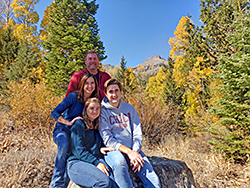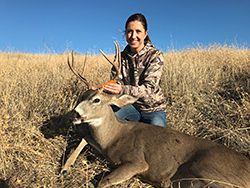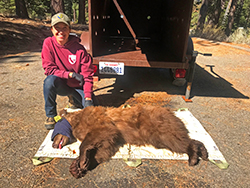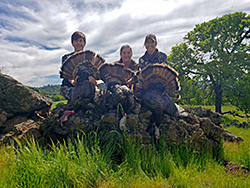
The Hope Valley Wildlife Area in Alpine County makes for great hiking in the fall and snowshoeing in the winter. Shelly, who helps manage the area for CDFW, enjoys a fall day there with her family.

Shelly shows off the D3-5 buck she harvested last deer season.

Shelly tags a sedated bear captured in the Tahoe basin. The bear was hazed upon release to keep it fearful of humans and away from developed neighborhoods.

Hunting season is family time for the Blairs. Shelly, her children Jesse and Amy, pose with their spring turkeys.
Shelly Blair is an environmental scientist with the California Department of Fish and Wildlife’s (CDFW) North Central Region. She serves as the unit wildlife biologist for Alpine and El Dorado counties.
Based out of her hometown of Placerville, Shelly’s ties to the local community and CDFW run deep. Her father, the late Bob Pirtle, was a California game warden for 30 years, with most of his career spent patrolling El Dorado County. Shelly’s brother, Sean Pirtle, is a CDFW wildlife officer in Yuba County.
In addition to conducting wildlife research and dealing with a variety of human-wildlife conflicts, Shelly manages CDFW lands in the two counties, which include the popular Hope Valley Wildlife Area, and the Heenan Lake and Red Lake wildlife areas. She holds a biology degree from Chico State.
What was it like growing up the daughter of a game warden?
I tell people I was a Fish and Game brat because it was so much a part of our lives. It was a wonderful childhood. We had wildlife around us all the time. My dad would have to confiscate fawns from people keeping them illegally. He would bring them home and we’d care for them a couple of nights. We had injured wildlife of all kinds. And my brother and dad have been avid hunters. They lived and breathed it – and my brother still does. All this amazing exposure to wildlife and the outdoors propelled us to follow in my dad’s footsteps.
In your job, you must run into some of the same people and families that you grew up with and who knew your father.
I do. I feel very privileged to be able to work in the same area my dad patrolled. These are my stomping grounds. It’s like an extension of my backyard. It is an honor to be investing in the people he was invested in – all the ranchers he worked with and all agency folks he had working relationships with. And now I’m able to carry on those relationships. I’m fortunate enough to have my dream job. This is always what I wanted to do – be the wildlife biologist for El Dorado County. I am very involved with the local schools and the community. I love to mentor students who are interested in what I do, and I try to instill a passion and appreciation in them for the work that we do. A lot of people don’t even know this is a career opportunity that’s available to them.
How did your career with CDFW begin?
It was a long and winding path. I volunteered right out of high school at our Wildlife Investigations Lab (in Rancho Cordova) and had a lot of different experiences there. I held a lot of scientific aid jobs while I was in college. I worked for our North Central Region 2 office. I worked in downtown Sacramento for our Upland Game Program. I worked in our education and outreach branch. I worked with the interpretive staff at the Gray Lodge Wildlife Area, and at the hunter check station at the Upper Butte Basin Wildlife Area. So when I graduated from Chico State with my biology degree I thought I was a shoo-in for a job at Fish and Game. I think I applied for eight positions – and didn’t get any of them.
But I also applied for a position with the California Department of Food and Agriculture. It was the only wildlife biologist position within the entire agency – kind of a trial to interface with the U.S. Department of Agriculture’s Wildlife Services. And they hired me. So that was my first permanent position. And I’m actually so grateful for that experience because what I learned in that job was so valuable to what I’m doing today with all the human-wildlife conflict. It totally prepared me for what I’m doing now.
I did that for five years. Food and Agriculture lost funding to continue the position, and I had kids at home and wanted to spend more time with them so I quit. About a week later I got a call from Pam Swift at our Wildlife Investigations Lab about a scientific aid job with the Chronic Wasting Disease (CWD) monitoring program. She told me I could work from home – and that was my foot back into the door with CDFW. That was in 2005. I got a permanent position in the Wildlife Investigations Lab in 2007 and my current job came open in 2010.
What’s a typical day like?
It completely varies. I can have a day all planned out where I am going to focus on a specific thing and then I will get a phone call about a wildlife conflict event or a wildlife welfare incident and I have to respond.
There’s a lot of field work in the spring and summer. All of our unit biologists coordinate and help each other with our different research projects – whether it’s deer darting or helicopter surveys or elk work. Obviously, there is more access to our higher elevation lands in the summer. I attend agency coordination meetings and county Fish and Game commission meetings so that I can remain engaged in the local community environmental issues and enhance interagency cooperation. The human-wildlife conflict work is often what we spend the majority of our time doing.
What kind of human-wildlife conflicts are you dealing with?
Wild turkeys. Mountain lions. Bears. I manage a lot of the South Lake Tahoe bear issues, and it’s one of the biggest challenges for my area. We’re getting more vineyards in my counties so I’m getting a lot more deer depredation calls. I deal with a lot of animal welfare issues because there is a huge wildlife feeding problem in El Dorado County. The result of that is deer getting caught in fencing, wire getting wrapped around their antlers and a lot of deer congregating in certain areas. I’ve had to rescue a lot of animals the last few years.
Besides being illegal, folks are doing more harm than good by feeding the deer?
They are bringing the animals closer to homes by feeding them – and that’s where there are a lot of obstacles they can get stuck in. Feeding encourages animals to congregate unnaturally, causing disease spread, habituated behaviors and unhealthy food options for the animals.
What’s the most rewarding project you’ve been involved with at CDFW?
I have a deer research project that I’m leading in the Crystal Basin area. We’re in the fifth year. It’s the Pacific Deer Herd on the western side of the Sierra. They are a mule deer-black-tailed deer cross. They are migratory deer, but they winter with resident deer, which is really interesting.
It started as a capture and collaring project to figure out survival and mortality, but it has expanded because the GPS collar data have given us great information on their migration, timing and behavior. We are discovering a lot of interesting things about these deer; it’s like pulling back the curtain on an amazing ecological mystery on the landscape. These deer haven’t been monitored since the 1980s, and the technology is so much better now that we can not only see what they are doing but sometimes understand why they are doing it or at least speculate as to why.
So what are we learning about these deer?
Their movement patterns, for starters. Some of them will go from winter range to summer range and then back in a two-week period. These exploratory movements cause an enormous amount of energy expended in such a short time. They spend a lot of time in burn areas and old fire scars. Obviously, there is better feed there and successional growth but how long are they going to keep doing that? We’ve also learned that they die a lot. There is a huge mortality rate for this herd – mostly from mountain lions, but we’ve also had four poaching incidents and three diseased deer.
In all of our many hours trying to dart and collar deer for the study, we drive around in varying areas of their summer range. Most of the time we find the deer hanging around campground areas where there’s a lot of human activity and recreation. So we’ve started to think about that while looking at the high mortality rates. And none of the mortalities ever really happens in those areas. So one theory we have – and I’m not sure how we would actually prove it – is that these deer have learned it’s safer to be around people because there are not as many predators that want to be in those areas.
Other observations are in the more remote areas where you think you would find a lot of deer and where there is just all this beautiful habitat – and we don’t see deer in those areas anymore. It begs the question: Are these deer changing their behavior to adapt to the predators? It’s just really interesting.
Tell us something about yourself many people would be surprised to learn.
I’m a hunter education instructor. I got the idea after my kids went through hunter education and I thought I could create a fun, interactive class. I teach with my colleague Sara Holm. We enjoy seeing the kids succeed and then venturing out to participate in this hunting tradition.
I love to hunt and fish, but I worry that the hunting tradition is dying. I’ve tried to instill in my own kids an appreciation for the entire hunting experience; that it isn’t just about the harvest. It was important to my dad as well. Before he passed, he bought us all lifetime hunting licenses. I’ve had the most precious, memorable times with my dad, brother, husband and my kids while we’ve been out hunting.
When we teach our hunter education classes, there are some people in there who just want their kids to learn gun safety. They are not really interested in hunting. But we really emphasize the whole experience of hunting. Hunting affords you such unique opportunities to experience wildlife and ecology and become part of that natural process. And if you go out and don’t get anything you’ve still had a great day.
What do you most like to hunt and fish for?
I love spring turkey hunting. It’s such an adrenaline rush and beautiful to be outdoors that time of the year. I love duck hunting because there really is no other reason to be up at 2 a.m. to sit in an often wet, cold duck blind other than to watch the sunrise and hear the birds flying and chattering above. I love fly fishing. Unfortunately, my busy family schedule doesn’t allow me to do it very often but there’s just something about the rhythm of it and being on the water.
I haven’t done much deer hunting, but I did get a deer this past year hunting with my brother in D3-5. I’m not a trophy hunter. You can’t put the antlers in soup. I want the meat. There’s something unique about harvesting game that you will consume. It’s delicious and healthy, too.
CDFW Photos. Top Photo: Shelly rescues a deer that was tangled up in a rope swing. Wildlife welfare and human conflict issues occupy much of her time.